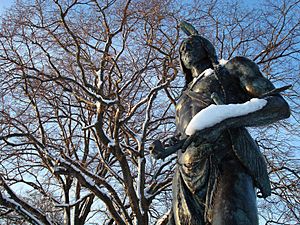King Philip's War facts for kids
Quick facts for kids King Philip's War |
|||||||
|---|---|---|---|---|---|---|---|
| Part of the American Indian Wars | |||||||
 An artist's rendition of Indians attacking a garrison house |
|||||||
|
|||||||
| Belligerents | |||||||
Mohegans Pequots |
|||||||
| Commanders and leaders | |||||||
|
|||||||
| Strength | |||||||
| c. 3,400 | c. 3,500 | ||||||
| Casualties and losses | |||||||
| c. 3,000 | c. 1,000 | ||||||
King Philip's War was a big conflict that happened in New England from 1675 to 1678. It was fought between Native American tribes and the English colonists who lived there. The war is named after Metacomet, a chief of the Wampanoag tribe. He was also known as "King Philip" to the English. His father, Massasoit, had been friends with the Pilgrims who arrived on the Mayflower. The war ended in April 1678 with a peace agreement called the Treaty of Casco Bay.
Contents
Why the War Started: Background

When the Puritans came from England, they settled in America near the Native Americans. The Pilgrims, who founded Plymouth Plantation, tried to be friends with the Native Americans around Cape Cod. They made peace with Massasoit, the chief of the Wampanoag tribe.
Massasoit had a long-standing friendship with the colonists. After Massasoit died, his son Metacomet became the tribal chief in 1662. As more Puritans moved to America, they needed more land. This often meant taking land from the Native Americans. Metacomet, or "King Philip," was upset that the colonists were taking Native American lands. He felt they were not keeping the peace that his father had worked for.
By 1675, the early friendship had broken down. The colonists wanted the Native Americans to give up their guns, which made the tribes feel unsafe.
The War Begins and Spreads
Colonial governors like Josiah Winslow and John Leverett sent their soldiers, called militia, to attack Native American villages. One major attack was on the Narragansetts' main fort. This battle was called the Great Swamp Fight. About 150 Narragansetts were killed, including women and children. The Narragansetts had tried to stay neutral, but some of their people had helped in raids, so the colonists attacked them.
King Philip gathered different Native American groups. They attacked the Puritan settlements, pushing back the colonial frontier. They burned towns, including Providence in March 1676.
The fighting spread across Massachusetts, Rhode Island, Connecticut, and Maine. By the end of the war, the Wampanoags and their Narragansett allies were almost completely destroyed. King Philip himself fled to Mount Hope, where he was eventually killed. About 3,000 other Native Americans died during King Philip's War. Around 500 Native Americans were also captured and forced into slavery.
Important Facts About the War
King Philip's War is often seen as one of the deadliest wars in early American history. It was a time when the colonists started to feel like they had their own identity, separate from England. They had won a war without direct help from Britain's government or military.
This war was one of many conflicts between Native American tribes and the French, Dutch, and English settlers in places like Canada, New York, and New England.
Many Native Americans in the Northeast had already died from diseases like smallpox, spotted fever, typhoid, and measles. Plymouth Colony was founded in 1620 with help from local Native Americans, especially Squanto and Massasoit. As more colonies were built, settlers continued to spread into the lands of various Algonquian-speaking tribes.
Interesting Facts About King Philip's War
- King Philip's older brother died while being held by the colonists. This made Philip chief when he was just 24 years old.
- King Philip (Metacomet) was named after King Philip of Macedonia from Ancient Greece.
- The Nipmuck, Podunk, Narragansett, and Nashaway tribes fought alongside King Philip and the Wampanoag.
- The Mohegan and Pequot tribes sided with the colonists.
- The war started when Wampanoags attacked the village of Swansea. This happened after three Wampanoags had been executed for murder.
- About one in ten soldiers on both sides of the war were killed.
- After Metacomet (King Philip) was killed, his body was treated harshly. The man who killed him kept his head and one hand and charged people money to see them.
Images for kids
-
"King Philip's Seat," a meeting place on Mount Hope, now in Bristol, Rhode Island.
-
Engraving depicting the colonial assault on the Narragansetts' fort in the Great Swamp Fight in December 1675
-
Benjamin Church: Known as the "Father of American Rangers"
-
Native revenge on Richard Waldron for his role in King Philip's War, Dover, New Hampshire (1689)
-
The site of King Philip's death in Misery Swamp on Mount Hope (Rhode Island)
See also
 In Spanish: Guerra del rey Felipe para niños
In Spanish: Guerra del rey Felipe para niños









